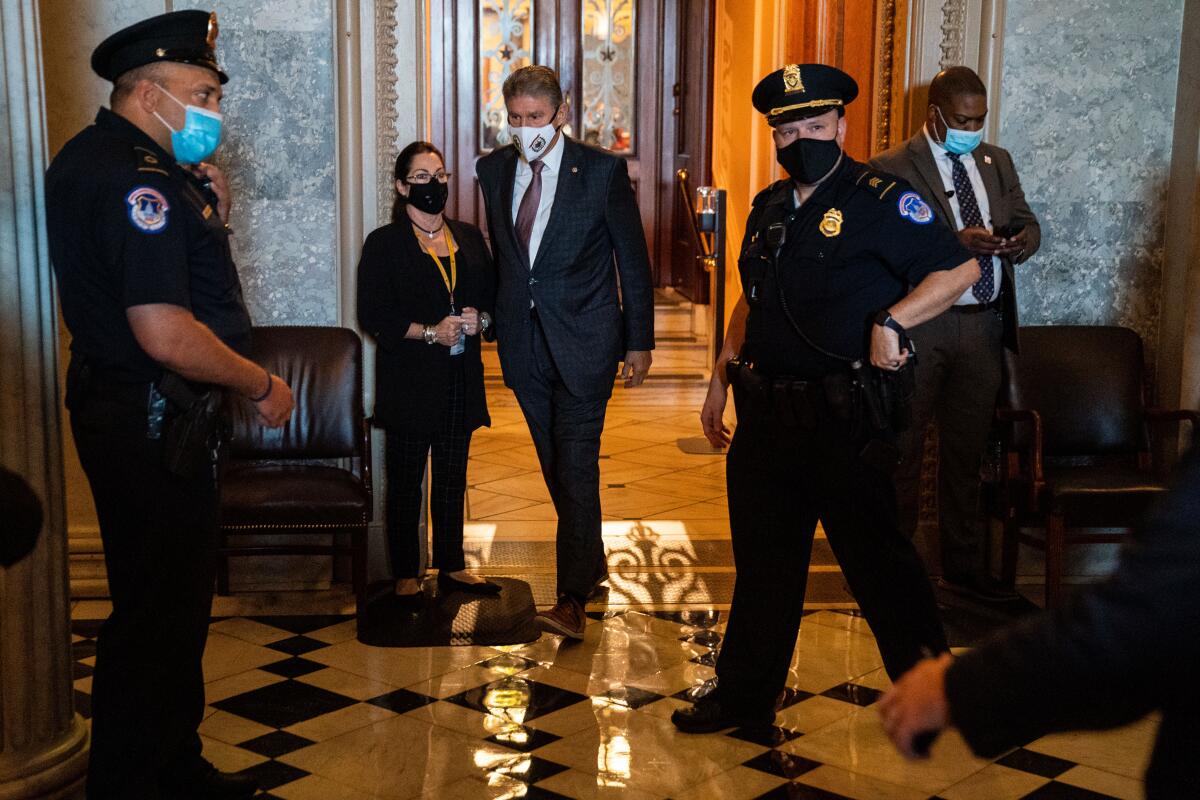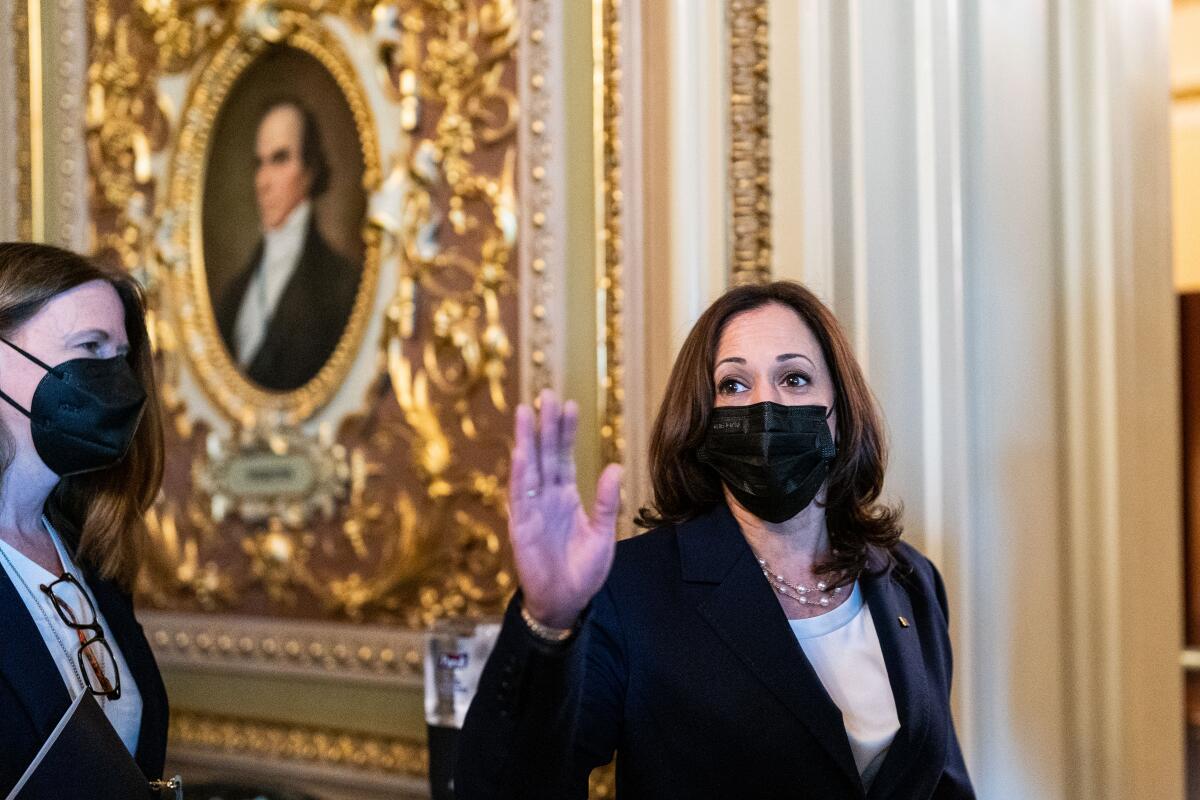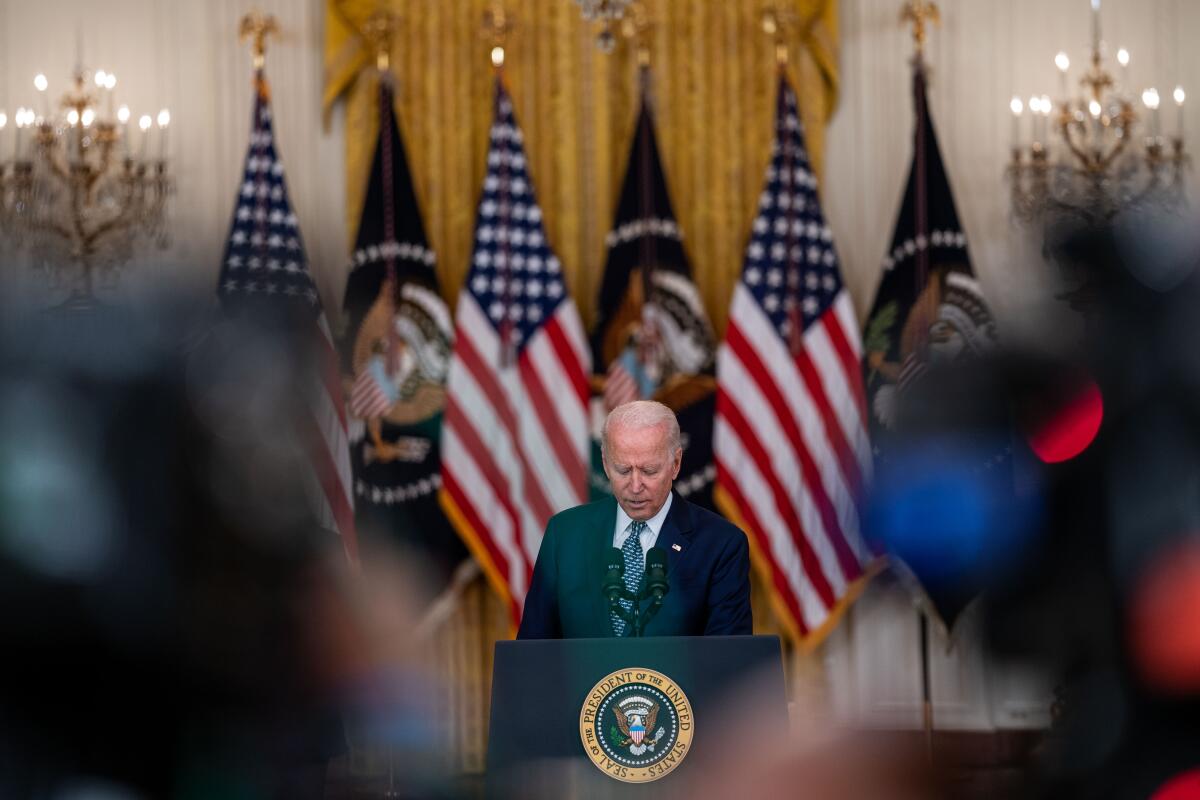Senate approves Biden’s bipartisan infrastructure bill with funds for California

- Share via
WASHINGTON — The Senate on Tuesday approved an expansive bill to rebuild the nation’s aging roads and bridges, with $8.3 billion specifically targeted to water infrastructure projects in the West and billions more to fund national projects to mitigate the impact of wildfires.
After months of negotiation among President Biden, Democrats and a group of moderate Republicans to forge a compromise, the Senate voted 69 to 30 in favor of the legislation. In the end, it had support from 19 Republicans, including Minority Leader Mitch McConnell of Kentucky.
The plan, which is the first portion of Biden’s “Build Back Better” program, will next go to the House, where it faces challenges from progressives.
Ten centrist senators who worked on the bill, including lead negotiators Rob Portman (R-Ohio) and Kyrsten Sinema (D-Ariz.), said it would “create jobs, increase productivity and pave the way for decades of economic growth and prosperity — all without raising taxes on everyday Americans or increasing inflation.”

Biden similarly framed the accomplishment as proof he has delivered on his campaign promise to govern from the political center.
“This is about us doing the real hard work of governing,” Biden said. “This is about democracy delivering for the people. This is about winning the future.”
The comity was short-lived. Just moments after the bipartisan vote on the bill, the Senate turned to the second portion of Biden’s infrastructure plan, an ambitious effort to reshape the nation’s social programs.
It could accomplish many of progressives’ top policy priorities, such as implementing paid family leave and a universal prekindergarten program, expanding Medicare and enacting a pathway to citizenship for some immigrants.
Because the proposal is sharply opposed by Republicans who say it is too expensive, Democrats hope to enact it through a legislative procedure that doesn’t allow for a GOP filibuster. But significant hurdles remain: All of the legislation has to be deemed to meet a narrow set of rules for how the procedure can be used and Democrats have to remain politically united.

The Senate voted 50 to 49 along party lines to start work on that plan. The framework is expected to be approved in the early hours of Wednesday after an hours-long series of amendment votes. A detailed plan is not expected to pass until after the August recess.
The approximately $1-trillion bill approved Tuesday would address a wide range of infrastructure deficiencies and expand the availability of broadband internet throughout the country.
About $110 billion would go to roads, bridges and other major surface transportation projects. Passenger rail gets $66 billion, public transit gets $39 billion, and safety programs for highways and pedestrian walkways get $11 billion. About $55 billion would go to expanding access to clean drinking water.
Congress didn’t choose which specific projects would be funded. Those decisions will be made later by government agencies.
There could be big winners in California. For instance, the California High-Speed Rail Authority is already eyeing pockets of money it can apply for to fund its rail project between San Francisco and Los Angeles.

Authority spokeswoman Melissa Figueroa said the agency sees about $20 billion to $40 billion in the bill that it could be eligible to compete for and, pending finality of the legislation, plans to apply.
“The message that we’re getting out of the federal government is that they want to invest in clean, green electrified rail and high-speed rail, and that’s what we’re under construction on here in California,” she said. “That’s the direction we think they want to go, and that makes us very competitive.”
Transportation Secretary Pete Buttigieg declined to predict which projects might be selected for funding.
In an interview, he called California’s project “a major high-speed rail vision. It’s well underway, and I imagine that there will be multiple opportunities to seek support that will be helped by the funding we are hopefully about to get.”
A handful of other provisions could have an outsize benefit to California in particular.
More than $3.3 billion would fund wildfire risk reduction, such as mechanical thinning and controlled burns. Billions more would pay for infrastructure projects that could mitigate the impact of wildfires and other natural disasters, such as rehabilitating burned lands, burying power lines and fireproofing homes. It would also boost the pay of federal wildland firefighters to bring them to parity with state firefighters.

The most sizable fund that will directly affect the state is the more than $8 billion for water initiatives in the West. That includes $1 billion for water recycling systems and more than $1 billion for water storage and groundwater storage projects to take advantage of wet years.
“It’s welcome money that’s going to bring benefits for years,” said Felicia Marcus, a fellow at Stanford University’s Water in the West Program and former chair of the California State Water Resources Control Board. “The modern configuration of the Western United States is impossible without massive infrastructure improvement.”
Sen. Dianne Feinstein (D-Calif.), whose office worked with that of Senate Energy and Natural Resources Committee Chairman Joe Manchin III (D-W.Va.) on several water provisions, says much of the funding will go to California projects.
The U.S. Bureau of Reclamation, which oversees water management in the West, will ultimately decide what projects get funded. But there is a relatively small universe of water projects that will be eligible, and many of them are in California, giving the state a leg up.
Old dams, canals and other infrastructure will be upgraded with $3.2 billion over five years. Although that’s short of the $4.6 billion the bureau identified as needed over the next five years, it’s significantly more than its annual budget.
Congress is using the money to move the bureau to more forward-looking water policy, particularly on water recycling and employing nature-based solutions, such as using tools that mimic nature to conserve water.
“They had a lot of experience and history in building the hard traditional infrastructure [such as] dams and canals. So as we looked to the future, we were thinking about what does a 21st century water agency look like?” said an aide involved in the bill who was not authorized to be identified.
To that end, there is $100 million for natural infrastructure projects, such as using nature or tools that mimic nature to conserve water, and another $100 million to improve overall watershed health. The bureau will also have new funding for aquatic ecosystem restoration projects that are designed to improve wildlife habitat.
The new funding for groundwater storage comes amid a shift for the federal government, which provided no sizable amount of money for such efforts before 2016, according to water policy experts.
“Water recycling and desalination programs in particular will help California stretch supplies without diverting water from rivers and the delta or harming the environment,” Feinstein said. “Ecosystem restoration, water conservation and water-use-efficiency funds will help us more wisely use what water we do have.”
Times staff writers Eli Stokols and Janet Hook contributed to this report.
More to Read
Get the L.A. Times Politics newsletter
Deeply reported insights into legislation, politics and policy from Sacramento, Washington and beyond. In your inbox three times per week.
You may occasionally receive promotional content from the Los Angeles Times.











